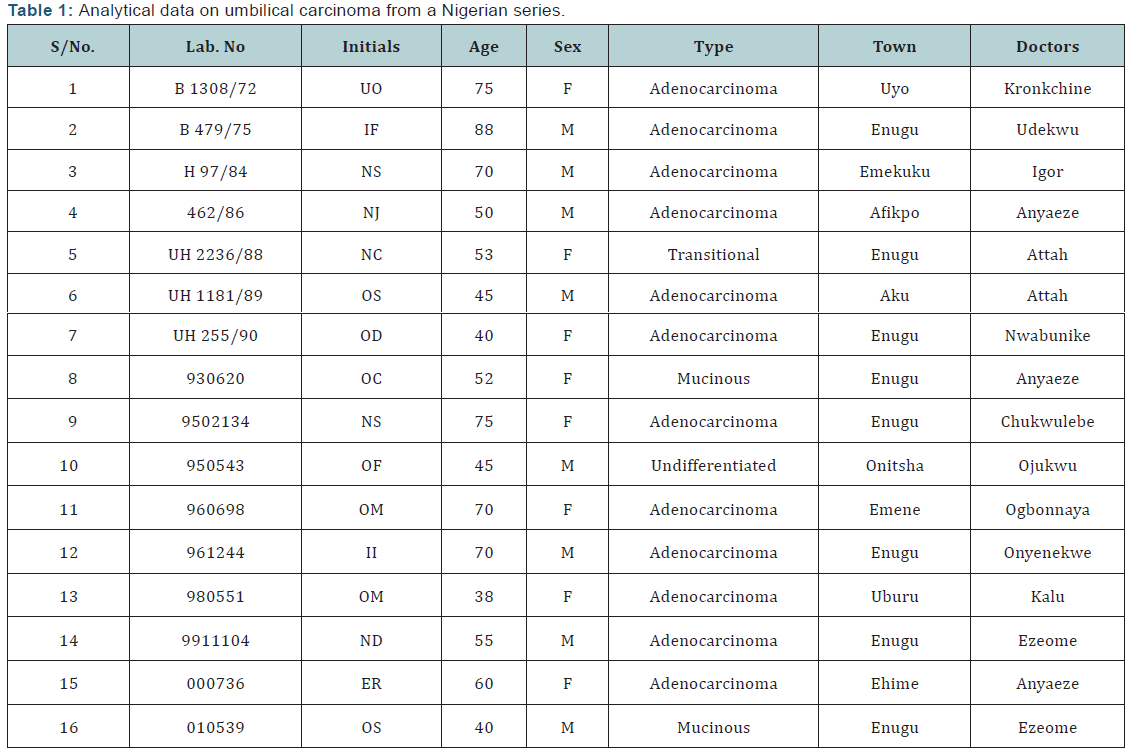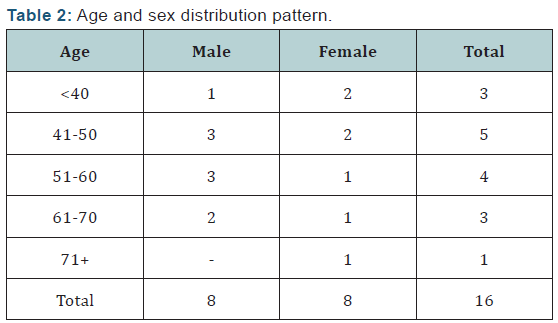Metastatic Adenocarcinomas of the Umbilicus in a Developing Community
Cancer Therapy & Oncology- Juniper Publishers
Abstract
Popularized as the “Sister Joseph’s nodule” is the metastatic lesion of the umbilicus. Hitherto, cases had been reported worldwide. Therefore, this article aims to document the patterns of it obtained among an ethnic group in a developing community. Incidentally, a few indigenous doctors suspected the lesions to be of the Sister Joseph nodule type. The epidemiological data included equality of sex and the preponderance of adenocarcinomas.
Keywords: Carcinoma; Umbilicus; Metastasis; Age; Type; Sister Joseph Nodule
Introduction
Metastatic carcinoma of the umbilicus gained prominence when, “during the early days of the Mayo Clinic, Sister Mary Joseph, the superintendent of St. Mary’s Hospital and Dr. William Mayo’s frequent first assistant, imparted this clinical observation to Dr. Mayo after noting a firm nodule of the umbilicus in many patients with intra-abdominal cancer” [1]. Indeed, Sharaki and Abdel-Kader [2] published on 12 cases and entitled them “the Sister Joseph’s nodule.” Likewise, “Sister Joseph’s nodule” topped the title of the 7 cases published by Brustman and Seltzer [3], as well as the single case of Bank and Liberman [4] and also that of Samitz [5].
Individual cases are noteworthy especially as they centered on the different primary growth from the skin [6] and the uterine cervix [7]. Accordingly, deserving of documentation is the author’s series from a developing community.
Investigation
The findings were made in Nigeria concerning 16 patients of the Ibo/Igbo ethnic group [8]. Moreover, the data came through a histopathology data pool just as was recommended for epidemiological analysis by a Birmingham (UK) group [9]. Doctors serving the populace were encouraged to carry out biopsies, to preserve them in normal-saline and to give adequate clinical details in the Request Forms. The data were analyzed personally.
Results


Discussion
Of the more recent findings, the tendency is still to dwell on the Sister Joseph nodule nomenclature. Thus, Palaniappan [10] and group saw a case series in which 4 Sister Joseph nodules came from 4 different viscera, namely, gall bladder, ovary, rectum and gastrointestinal stroma. The literature came from Morocco [11], Taiwan [12], Greece [13] and India [14].
Conclusion
Therefore, my cases from Nigeria need documenting especially in terms of
- the equal contribution from both sexes,
- the equal contribution coming from Enugu as opposed to the rest of the towns,
- the tendency to predominate in the 41 to 50 age group,
- the preponderance of adenocarcinoma, and
- Most of the doctors sending but a single specimen.
To Know More About Cancer Therapy & Oncology International Journal Please click on:
https://juniperpublishers.com/ctoij/index.php
For more Open Access Journals in Juniper Publishers please click on: https://juniperpublishers.com/index.php
For more about Juniper Publishers Please click on: https://juniperpublishers0.wixsite.com/juniperpublishers


Comments
Post a Comment